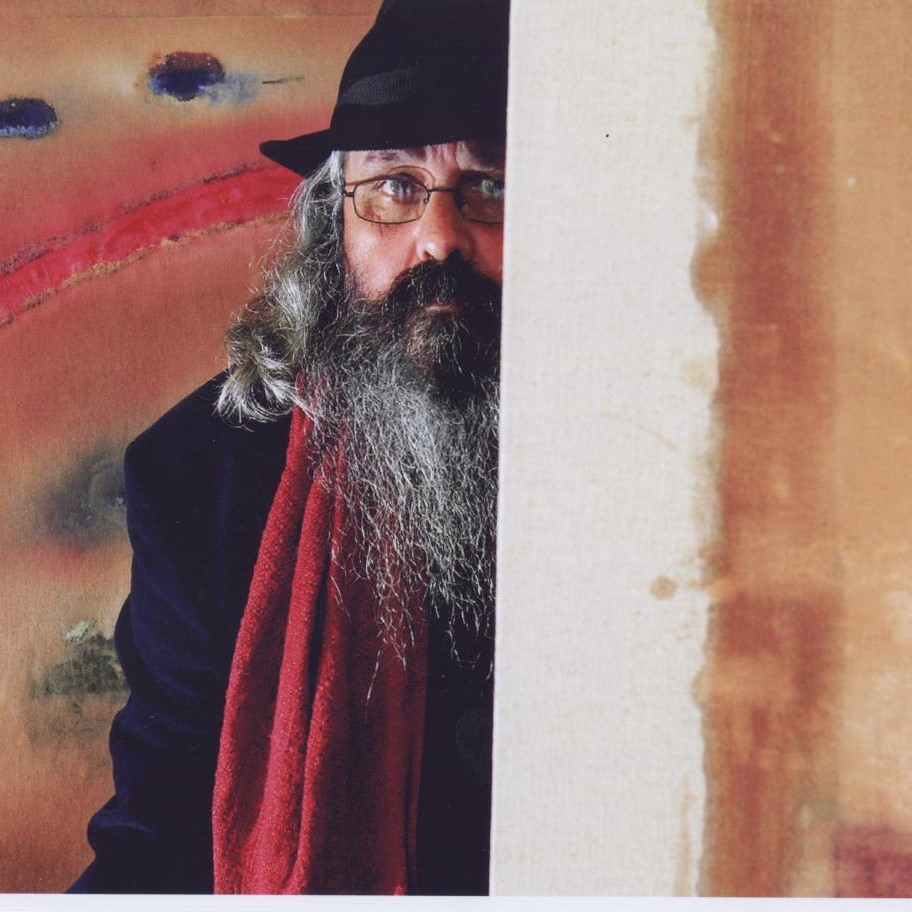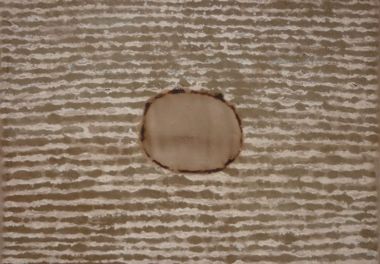'Boodja Yaaragut (Earth on Top)'- Lindsay Harris
Lindsay has been recently selected as one of the top 20 indigenous artists in Australia for the upcoming exhibition 'unDisclosed: 2nd National Indigenous Art Triennial' to be held at the National Gallery of Australia in 2012. This is great recognition for an important practitioner of Noongar contemporary art.
Lindsay Harris was born in 1947 and grew up in Kwolyin, a small town in the central wheat belt of Western Australia. As a child Lindsay remembers playing and exploring the bush and granite outcrops that were prevalent around this area and these early childhood experiences have had a profound influence on Lindsay which is demonstrated in his artwork. To a visitor travelling through Kwolyin today all that remains standing is a solitary church and the road going through the town site but to Lindsay this area remains deeply and permanently entrenched in his memory. Lindsay endeavours to delve beneath the surface of the town’s deserted facade to reveal the deeper layers and undercurrents that underpins his people’s history.
He grew up in a pivotal era where family members and Aboriginal groups recount being frequently harassed and threatened by the Department of Native Affairs of the time and other authorities. It was a time of unease and simmering tensions for the indigenous population of Australia and Lindsay recalls his family’s stories of segregation and cultural isolation.
Lindsay remembers a visit to Quairading as a youngster with his maternal grandmother and their experience of such segregation in a local cafe. After ordering their lunch Lindsay automatically went to sit down in the cafe but was shepherded outside by his grandmother to eat their sandwiches on the ground next to the railway line. She explained to him some time later that this had occurred because she was black and not permitted to eat in the cafe .Lindsay recalls another story where his mother and her siblings inscribed their names on the large granite rocks where they lived. The inscribed rock faced the railway line and every passing passenger on the train could see it. This work of Lindsay’s mother and siblings was done during the period in Western Australian history when children were actively taken and stolen away from their families. This was a sign of nourishment to those who remained, a sign of comfort and security. It was also a sign of defiance. They did not intend to become ‘stolen children’ taken away. However if they were to be forcibly taken away, the inscription on the rock suggested that this was still their place and they had left their mark. Despite such personal experiences of imposed restrictions, today Lindsay only seeks to recognise these issues in a positive, apolitical and non judgemental way by incorporating elements and motifs of those stories in his work. In making his art he considers himself to be a messenger and bearer of cultural continuity for his people.
One of the most distinctive hallmarks of Lindsay’s paintings is his unique use of hemp. To this he applies a range of pigments, clays and resins sourced from marri trees growing locally. These convey an earthy palette and texture reminiscent of the landscape that he is so passionate about. His powerful abstract compositions of circles and lines demonstrate an almost topographical sense of the gnaamaar holes, salt lakes and tracks that typify the area around Kwolyin. Dramatic and confident broad horizontal brush strokes of clay can be simultaneously construed as depicting both the degradation of the land by thousands of years of habitation by both indigenous and non indigenous people and the ceremonial scarring of the Noongar men and their tracks of existence. Hidden beneath the stripes are faint traces of resin, pigment and deliberate creases in the hemp signifying family and the heavy weight of their untold stories from a turbulent time in Noongar history.
It is not surprising therefore that the footprints of his ancestors on the boodja (land) and the spirit of the generations that followed have left an indelible imprint on Lindsay that permeates everything in his art.
On completing a degree in Fine Arts at Curtin University, WA in 2005, he subsequently completed his Honours (Fine Art) in 2006 and Masters’ degree in 2008. Since then Lindsay has been working as a full time artist in his studio at his home in Lesmurdie, situated in the Perth Hills of Western Australia. Lindsay held his first solo exhibition at emerge ART SPACE, Perth in 2006 during his Honours year. He has held numerous successful solo exhibitions both in Perth and Melbourne and has his first international solo show scheduled for April 2012 to be held in Singapore.







